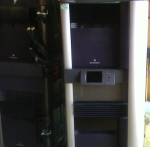So, I had a unique problem yesterday.
I only had Install Tools Supportfolio overlay sets, not real CDs.
And the Install Tools overlay sets don't have a stand directory, and therefore don't have fx.
So I did a little poking around, and learned that fx can be found in the eoe set.
The problem? I don't have a working IRIX host at the moment, so I found myself without inst.
So I did a little looking.
For each distribution set there's a simple .idb file which contains, in plaintext, offsets and compressed sizes (CMPSIZE).
Then, the .sw file contains the data associated with each file, compressed using the oldschool BSD compress utility (the one from the 80s).
So all you've got to do is:
1) Open up the .idb file in a text editor, and search for the file you're looking for (telling fx from fx64 takes a minute, because fx64 is also named just fx, but you can figure it out). Find the OFFSET= and CMPSIZE= lines.
2) Go to this OFFSET (it's in bytes) in the .sw, using a hex editor. Look for the filename (it should be a few bytes after the OFFSET= value).
3) Copy out CMPSIZE bytes *AFTER* the FILENAME (the area you're copying, if you're doing it right, should start with 1f 9d, the magic numbers for compress files) into a new file with extension .Z i.e. fx.Z (be *sure* to copy and count bytes starting from 1f 9d / right after the filename, NOT right after the offset, or you'll get a truncated file. uncompress will still uncompress it without error, and then you'll be in a world of confusion as everything barfs on a file you thought was correct).
4) Run uncompress on the .Z file you just got.
Ta-da! There's a file, extracted from a .sw/.idb distribution set. Not *too* hard, was it?
I only had Install Tools Supportfolio overlay sets, not real CDs.
And the Install Tools overlay sets don't have a stand directory, and therefore don't have fx.
So I did a little poking around, and learned that fx can be found in the eoe set.
The problem? I don't have a working IRIX host at the moment, so I found myself without inst.
So I did a little looking.
For each distribution set there's a simple .idb file which contains, in plaintext, offsets and compressed sizes (CMPSIZE).
Then, the .sw file contains the data associated with each file, compressed using the oldschool BSD compress utility (the one from the 80s).
So all you've got to do is:
1) Open up the .idb file in a text editor, and search for the file you're looking for (telling fx from fx64 takes a minute, because fx64 is also named just fx, but you can figure it out). Find the OFFSET= and CMPSIZE= lines.
2) Go to this OFFSET (it's in bytes) in the .sw, using a hex editor. Look for the filename (it should be a few bytes after the OFFSET= value).
3) Copy out CMPSIZE bytes *AFTER* the FILENAME (the area you're copying, if you're doing it right, should start with 1f 9d, the magic numbers for compress files) into a new file with extension .Z i.e. fx.Z (be *sure* to copy and count bytes starting from 1f 9d / right after the filename, NOT right after the offset, or you'll get a truncated file. uncompress will still uncompress it without error, and then you'll be in a world of confusion as everything barfs on a file you thought was correct).
4) Run uncompress on the .Z file you just got.
Ta-da! There's a file, extracted from a .sw/.idb distribution set. Not *too* hard, was it?


 <>
<>




 yeah
yeah
 ).
).